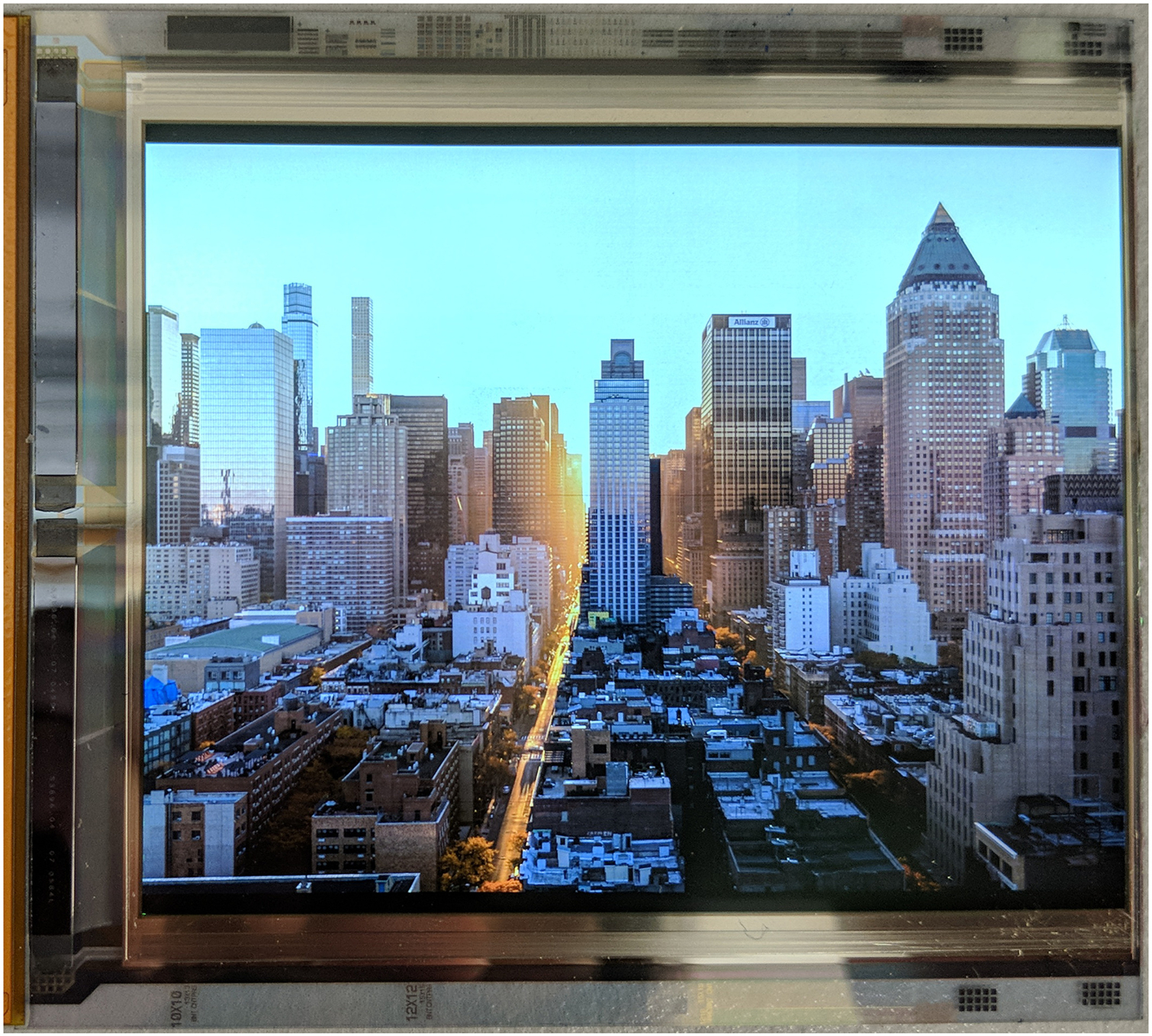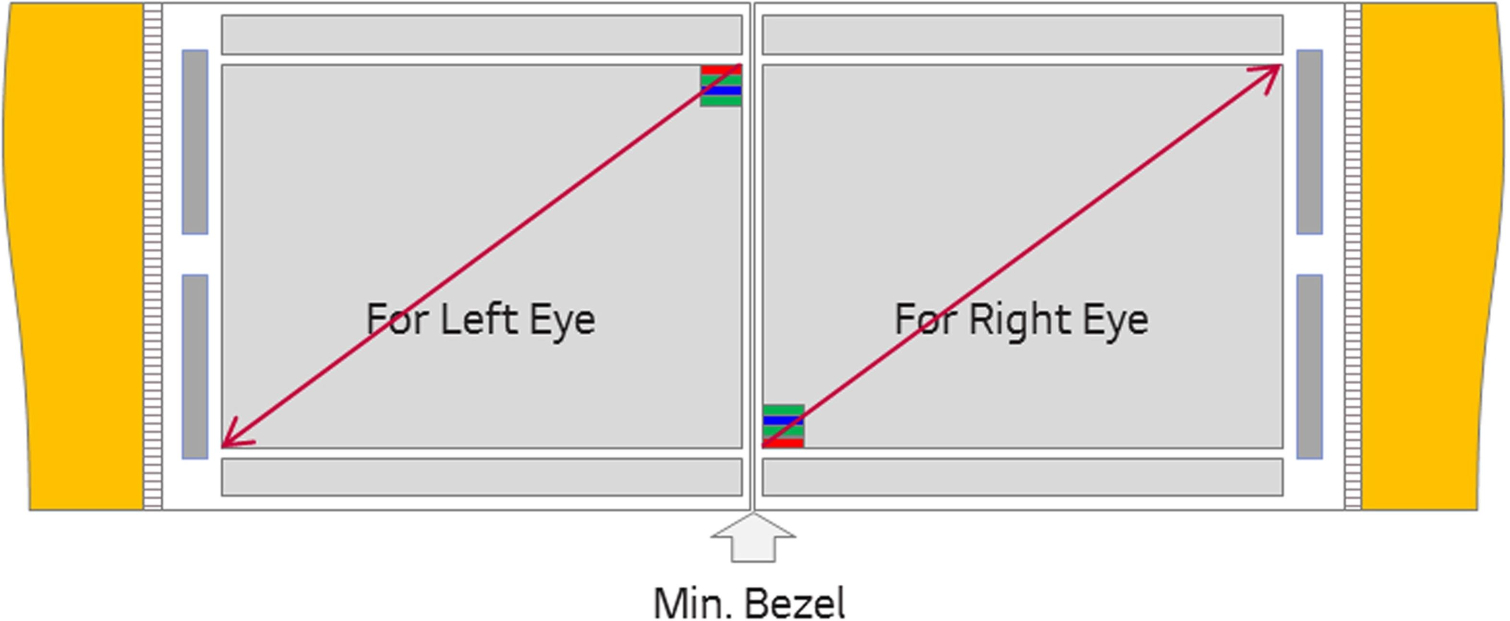LG, Google Designed An 18-Megapixel, 120Hz Display For VR Headsets
LG and Google are working together to improve display technology for VR HMDs and what they’ve come up with so far blows currently available displays out of the water. LG and Google created a 4.3” OLED display which boasts a 120Hz refresh rate (30Hz higher than the Rift and Vive) and a staggering 4,800x3,840 resolution.
SID International Display Week is going on this week, and LG and Google used the platform to reveal the details about a new display that the two companies are building for future VR devices. Representatives from both companies will present a research paper today that outlines the recently developed OLED panel, but the team published the paper publicly yesterday.
LG and Google’s new display is an ambitious project. The paper’s authors explain that they sought to create OLED panels that more closely match the human visual system. The goal was to engineer an on-glass OLED display which would offer higher than 100-degrees field of view (FoV), 1,000 to 2,200 pixels per inch (PPI), and 15-25 million pixels per eye. To put that into perspective, the Vive Pro and Samsung Odyssey, which include the highest-resolution VR displays available today, feature 615 PPI and 2.3 million pixels per eye.
The engineering teams at LG and Google have created a panel that meets the project’s criteria. The two companies developed a 4.3” OLED panel that features 4,800x3,840 pixels, which equates to 1443 PPI, or 18-megapixels. The panel also operates at 120Hz, which enables a motion-to-photon latency of 8.3ms/frame. The display also supports short persistence illumination, which is designed to reduce motion blur. LG and Google said the illumination process takes 20% of the frame time, which leaves 6.4ms/frame for the host device to render each frame. The current design also offers up to 120-degrees horizontal FoV and 96-degrees vertical FoV.
The team isn’t satisfied with the current results, and it is striving for even better results in the future. The paper’s authors suggest that the theoretical upper limits would be 9,600x9,000 pixels per eye, 2,183 PPI, and 160-degrees by 150-degrees FOV. We can’t imagine what type of graphics system would drive such a panel, though, so we don’t expect to see the upper limit panel anytime soon. However, LG and Google have already built working prototypes of the 18-megapixel display, which make them the highest density on-glass OLED panels ever created.
LG and Google used a two subpixel per pixel arrangement, which is often found in mobile phone displays. Each pixel features a green subpixel and either a red or a blue subpixel. The team used a white OLED structure with color filters to simplify mass production of the new panels because the traditional Fine Metal Mask processes used to build display panels don’t work well for displays with upwards of 1000 PPI.
LG and Google’s engineering teams designed two 18-megapixel displays to use in tandem in a VR HMD. The 4.3-inch panels feature electronics on three sides and a 1.7mm bezel on the forth side. When two panels are used together, the thin bezel sides should touch. The left-eye panel would draw diagonally from the top right to the bottom left, and the right side would draw from the bottom left to the upper right.
Get Tom's Hardware's best news and in-depth reviews, straight to your inbox.
LG and Google’s engineers also focused on ways to help the GPU drive the 18-megapixel display. The team created a foveated rendering technique which breaks the image into two acuity levels. The high-acuity zone, which is the visual sweet spot of the panel, is a relatively small portion of the display that is rendered at full resolution. The low-acuity zone, which includes everything outside the sweet spot, is rendered at the lower detail level to conserve bandwidth in the rendering pipeline. The display panels feature a built-in FPGA that combines the data from the low and high-acuity zones to create a full-screen image. The low acuity images come in at 1280x1922 pixels, and the FPGA upscales them to the panel resolution.
LG and Google didn’t give us any hints as to when we would see these 18-megapixel displays featured in a VR headset, but the team suggested that they would be ideal for standalone VR devices, so we would guess that LG is building a Daydream-compatible standalone VR device behind closed doors.
| Header Cell - Column 0 | LG, Google 18-Megapixel OLED |
|---|---|
| Size (diagonal) | 4.3″ |
| Subpixel count | 3840 × 2 (either RG or BG) × 4800 |
| Pixel pitch | 17.6 µm (1443 ppi) |
| Brightness | 150 cd/m2 @ 20% duty |
| Contrast | >15,000:1 |
| Color depth | 10 bits |
| Viewing angle2 | 30°(H), 15° (V) |
| Refresh rate | 120 Hz |
Kevin Carbotte is a contributing writer for Tom's Hardware who primarily covers VR and AR hardware. He has been writing for us for more than four years.
-
araczynski theoretically this should pretty much eliminate the screendoor and be as good as looking at a high def monitor at 2 feet away, nice.Reply -
Giroro "LG and Google used a two subpixel per pixel arrangement,"Reply
No wonder they have to push it to impossible-to-render resolutions just to mask the horrid "chain link fence" effect that are inherent to penile displays. They may be reaching 1443 "PPI", but I bet it looks noticeably worse than a 962 PPI (2/3 the resolution) display that uses real, square, RGB pixels. -
dabeargrowls Reply20991883 said:I'll believe it when there's a product available.
I agree! you can't drive the current VR sets in the highest performance mode without issues. What makes anyone think the current video cards can drive this? maybe 5 years from now but its doubtful with Nvidia's release rate for cards. Remember the 980TI and 1080TI is maybe 20% difference. 1180...maybe another 20% and can maybe drive the Vive Pro? I keep hearing everyone so excited about pimax. It will work, sure....with 3 - 1080TI maybe? if they can make 90hz (stuck at 80).
-
lorfa That 1443 PPI is actually pretty impressive. A 19" 5:4 display could have a resolution of 21410x17128. A 24" 16:9 display could have a resolution of 30182x16977.Reply -
rhysiam Reply
The foveated rendering with eye-tracking is potentially a complete and total game changer if it's well implemented. That's a massive *if*, of course, but if ultra high res VR takes off in the medium term, it'll be on the back of foveated rendering and eyetracking.20991927 said:20991883 said:I'll believe it when there's a product available.
I agree! you can't drive the current VR sets in the highest performance mode without issues. What makes anyone think the current video cards can drive this? maybe 5 years from now but its doubtful with Nvidia's release rate for cards. Remember the 980TI and 1080TI is maybe 20% difference. 1180...maybe another 20% and can maybe drive the Vive Pro? I keep hearing everyone so excited about pimax. It will work, sure....with 3 - 1080TI maybe? if they can make 90hz (stuck at 80).
Also you're massively underselling the 1080ti. A 1070 edges out the old 980ti. Once you take away the CPU bottleneck with 4K extreme settings the 1080ti is generally 60-80% faster than the 980ti (check out the Tom's Hardware launch review, the data is there).I'm not for a second suggesting that the next-gen cards will be able to run this display, but we are seeing steady progress and a well implemented FR + eye tracking system could be a complete game changer. -
dark_lord69 The fastest video cards in the world cant even come close to running this.Reply
Maybe by the time we get to the ?1980 Ti? In like 20 years or something.
As long as you have at least 4 of them at just under $5,000 total... *UGH*
Price and graphical power are BOTH issues this VR system will face before it can be a reality (no pun intended).
However, this IS very forward thinking as Virtual Reality needs a huge boost in the visual department to create "Photo Realistic" graphics. This level of realism though would make VR far more amazing. -
bit_user Reply
I'm gonna say the DGX-2 might get you in the ballpark. Especially if you use one per eye.20991637 said:We can’t imagine what type of graphics system would drive such a panel
https://www.nvidia.com/en-us/data-center/dgx-2/
The hardest part might actually be the connectivity to the HMD.
But the real answer is going to be foveated rendering. Hardware ray-tracing would make almost perfect FR almost trivial, assuming the eye-tracking is good enough. -
bigpinkdragon286 Reply
Completely agree that foveated rendering will go a long way toward making the workload more realistic for the rendering devices.20992345 said:
The foveated rendering with eye-tracking is potentially a complete and total game changer if it's well implemented. That's a massive *if*, of course, but if ultra high res VR takes off in the medium term, it'll be on the back of foveated rendering and eyetracking.20991927 said:
...20991883 said:...
Pascal behaves pretty much the same way that Maxwell 2 does. When you have parity of clock speeds and calculate for the difference in shader cores / render back ends, you pretty much get parity of performance. NVIDIA didn't give us more instructions per cycle with the Pascal release, or even a significant amount of increased rendering resources. They upped the clock speed, by a lot, which allows cards such as the 1070 to slightly outpace the 980 Ti part despite the fewer resources.20992345 said:Also you're massively underselling the 1080ti. A 1070 edges out the old 980ti. Once you take away the CPU bottleneck with 4K extreme settings the 1080ti is generally 60-80% faster than the 980ti (check out the Tom's Hardware launch review, the data is there).I'm not for a second suggesting that the next-gen cards will be able to run this display, but we are seeing steady progress and a well implemented FR + eye tracking system could be a complete game changer. -
cryoburner Reply
As the article mentioned (and Rhysiam already pointed out), the performance demands won't be anywhere near that high, since they are utilizing foveated rendering, which involves rendering the scene at a lower resolution, then using eye tracking to detect where the user is looking, and rendering that small portion of the screen at a higher resolution. The article actually points out that most of the scene is only being rendered at 1280x1922 pixels (I'm assuming per-eye), which might be comparable to a Vive Pro, while only a small area is getting rendered at the panel's full resolution. By doing that, they likely already have this running games on today's higher-end graphics hardware, at least in some capacity. I do suspect it may be some years before these panels actually appear in a consumer headset though.20992474 said:The fastest video cards in the world cant even come close to running this.
Maybe by the time we get to the ?1980 Ti? In like 20 years or something.
As long as you have at least 4 of them at just under $5,000 total... *UGH*
Price and graphical power are BOTH issues this VR system will face before it can be a reality (no pun intended).


